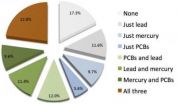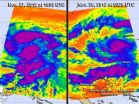(Press-News.org) A completely new method of manufacturing the smallest structures in electronics could make their manufacture thousands of times quicker, allowing for cheaper semiconductors. The findings have been published in the latest issue of Nature.
Instead of starting from a silicon wafer or other substrate, as is usual today, researchers have made it possible for the structures to grow from freely suspended nanoparticles of gold in a flowing gas.
Behind the discovery is Lars Samuelson, Professor of Semiconductor Physics at Lund University, Sweden, and head of the University's Nanometre Structure Consortium. He believes the technology will be ready for commercialisation in two to four years' time. A prototype for solar cells is expected to be completed in two years.
"When I first suggested the idea of getting rid of the substrate, people around me said 'you're out of your mind, Lars; that would never work'. When we tested the principle in one of our converted ovens at 400°C, the results were better than we could have dreamt of", he says.
"The basic idea was to let nanoparticles of gold serve as a substrate from which the semiconductors grow. This means that the accepted concepts really were turned upside down!"
Since then, the technology has been refined, patents have been obtained and further studies have been conducted. In the article in Nature, the researchers show how the growth can be controlled using temperature, time and the size of the gold nanoparticles.
Recently, they have also built a prototype machine with a specially built oven. Using a series of ovens, the researchers expect to be able to 'bake' the nanowires, as the structures are called, and thereby develop multiple variants, such as p-n diodes.
A further advantage of the technology is avoiding the cost of expensive semiconductor wafers.
"In addition, the process is not only extremely quick, it is also continuous. Traditional manufacture of substrates is batch-based and is therefore much more time-consuming", adds Lars Samuelson.
At the moment, the researchers are working to develop a good method to capture the nanowires and make them self-assemble in an ordered manner on a specific surface. This could be glass, steel or another material suited to the purpose.
The reason why no one has tested this method before, in the view of Professor Samuelson, is that today's method is so basic and obvious. Such things tend to be difficult to question.
However, the Lund researchers have a head start thanks to their parallel research based on an innovative method in the manufacture of nanowires on semiconductor wafers, known as epitaxy – consequently, the researchers have chosen to call the new method aerotaxy. Instead of sculpting structures out of silicon or another semiconductor material, the structures are instead allowed to develop, atomic layer by atomic layer, through controlled self-organisation.
The structures are referred to as nanowires or nanorods. The breakthrough for these semiconductor structures came in 2002 and research on them is primarily carried out at Lund, Berkeley and Harvard universities. The Lund researchers specialise in developing the physical and electrical properties of the wires, which helps create better and more energy-saving solar cells, LEDs, batteries and other electrical equipment that is now an integrated part of our lives.
INFORMATION:
The article 'Continuous gas-phase synthesis of nanowires with tuneable properties' can be found by entering "I 10.1038/nature11652" here: http://dx.doi.org/.
Besides Lars Samuelson, the other authors of the article are: Magnus Heurlin, Martin Magnusson, David Lindgren, Martin Ek, Reine Wallenberg and Knut Deppert, all employed at Lund University, except for Martin Magnusson, who works at start-up company Sol Voltaics AB.
The research has been funded by the Swedish Research Council, the Swedish Foundation for Strategic Research (SSF), the Knut and Alice Wallenberg Foundation and Vinnova.
For an animation of the production process, see: http://www.youtube.com/watch?v=Bhdr8z8d-Lo.
For more information, contact Lars Samuelson, +46 46 222 76 79, +46 703 17 76 79, Lars.Samuelson@ftf.lth.se. Contact details for the other authors can be found by searching on www.lunduniversity.lu.se.
Lund University Nanometre Structure Consortium, nmC@LU: www.nano.lth.se.
High-resolution photographs of Lars Samuelson are available in the Lund University image bank: https://bildweb.srv.lu.se/login/. Log in with username 'press' and password 'press', then enter the name into the search field.
About semiconductors:
Semiconductors are materials that neither conduct electricity as well as metals, nor stop a current as effectively as insulators – silicon and germanium are two examples. These properties may not sound attractive, but in actual fact they are excellent. The reason is that we can influence the conductive capacity of the materials, for example by introducing impurity atoms, known as doping. Materials with different types of doping can be combined to manufacture products such as transistors, solar cells or LEDs.
Research discovery could revolutionize semiconductor manufacture
2012-11-29
ELSE PRESS RELEASES FROM THIS DATE:
Women 16-49 at risk of multiple pollutants
2012-11-29
PROVIDENCE, R.I. [Brown University] — Nearly 23 percent of American women of childbearing age met or exceeded the median blood levels for all three environmental chemical pollutants — lead, mercury, and PCBs — tracked in an analysis of data on thousands of women by Brown University researchers. All but 17.3 percent of the women aged 16 to 49 were at or above the median blood level for one or more of these chemicals, which are passed to fetuses through the placenta and to babies through breast milk.
The study, published in advance online Nov. 15 in the journal Environmental ...
URI, IAA archaeologists discover shipwrecks, ancient harbor on coast of Israel
2012-11-29
KINGSTON, R.I. – November 28, 2012 – A team of archaeologists from the University of Rhode Island, the Israel Antiquities Authority, and the University of Louisville have discovered the remains of a fleet of early-19th century ships and ancient harbor structures from the Hellenistic period (third to first century B.C.) at the city of Akko, one of the major ancient ports of the eastern Mediterranean. The findings shed light on a period of history that is little known and point to how and where additional remains may be found.
The discoveries were presented on November ...
Order of psychiatric diagnoses may influence how clinicians identify symptoms
2012-11-29
The diagnostic system used by many mental health practitioners in the United States -- known as the Diagnostic and Statistical Manual of Mental Disorders -- assumes that symptoms of two disorders that occur at the same time are additive and that the order in which the disorders are presented doesn't matter. But new research suggests that order actually plays a significant role in determining how clinicians think about psychiatric disorders.
In an article published in Clinical Psychological Science, a journal of the Association for Psychological Science, researchers Jared ...
Geosphere builds momentum with 17 newly published studies and a new series
2012-11-29
Boulder, Colo., USA – Geosphere articles posted online 16 November 2012 cover a variety of topics, such as the geophysics of the Hogri fault zone, 5 km offshore of the Diablo Canyon nuclear power plant; using web-based GIS technologies and readily available global remote sensing datasets for investigations of arid land; the structure and evolution of the U.S. Sierra Nevada; the ANDRILL McMurdo Ice Shelf and Southern McMurdo Sound Drilling Projects; and climate-tectonic interactions in the southern Alaskan orogen.
Abstracts for these and other Geosphere papers are available ...
Infrared NASA imagery sees Tropical Storm Bopha grow a tail
2012-11-29
Tropical Storm Bopha continues to intensify in the western North Pacific Ocean as it heads toward Yap State, triggering more warnings and watches. Infrared imagery from NASA's Aqua satellite captured over two days revealed that the storm had consolidated, intensified and developed a large band of strong thunderstorms south of the center, that resemble a tail.
Infrared images of Tropical Storm Bopha were taken by the AIRS instrument on NASA's Aqua satellite on Nov. 27 at 1505 UTC when Bopha had maximum sustained winds near 45 mph, and on Nov. 28 at 0329 UTC when Bopha's ...
NASA's Cassini sees abrupt turn in Titan's atmosphere
2012-11-29
Data from NASA's Cassini spacecraft tie a shift in seasonal sunlight to a wholesale reversal, at unexpected altitudes, in the circulation of the atmosphere of Saturn's moon Titan. At the south pole, the data show definitive evidence for sinking air where it was upwelling earlier in the mission. So the key to circulation in the atmosphere of Saturn's moon Titan turned out to be a certain slant of light. The paper was published today in the journal Nature.
"Cassini's up-close observations are likely the only ones we'll have in our lifetime of a transition like this in action," ...
Study IDs kerosene lamps as big source of black carbon
2012-11-29
Berkeley — The primary source of light for more than a billion people in developing nations is also churning out black carbon at levels previously overlooked in greenhouse gas estimates, according to a new study led by researchers at the University of California, Berkeley, and the University of Illinois.
Results from field and lab tests found that 7 to 9 percent of the kerosene in wick lamps — used for light in 250-300 million households without electricity — is converted to black carbon when burned. In comparison, only half of 1 percent of the emissions from burning ...
Significant progress in intelligent radio-over-fiber (I-ROF) systems
2012-11-29
Driven by the strong demand for high-definition video, digital health services, the Internet of Things, and virtual reality, broadband, ubiquitous and convergent information access has become the most important engine to drive the development of the modern information society. With increasing numbers of information-based interactions among humans, machines and objects, especially as new services, new terminals and new needs emerge, the networks are required to provide flexible, energy-efficient, safe and broadband access services anywhere at any time, and therefore wideband ...
The neural toxicity of lanthanides: An update and interpretations
2012-11-29
Lanthanides comprise a unique and dominant resource of China. The increase in contact for populations through lanthanide mining and the wide applications for industry, agriculture, and medicine have raised great public concern regarding the metal toxicity of lanthanides, particularly on the issue of whether lanthanides are toxic to the human nervous system.
In the past decade, major progresses have been made toward elucidating the mechanisms of the biological actions of lanthanides. A recently published review by researchers at Peking University [Xia et al., Sci. China ...
An engraved stone artifact found at the Shuidonggou Paleolithic site, northwest China
2012-11-29
The origin and dispersal of modern humans and modern human behavior are key interests in Paleolithic archaeology and anthropology. Engraved objects are usually seen as a hallmark of cognition and symbolism, which are viewed as important features of modern human behavior. In recent years, engraved ochre, bones and ostrich eggs unearthed from various Paleolithic sites in Africa, the Near East and Europe have attracted the attention of many scholars. However, such items are rarely encountered at Paleolithic sites in East Asia. Here, we report a very important discovery of ...



